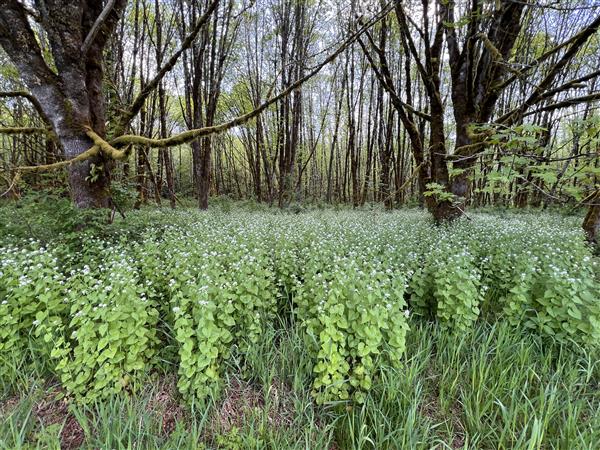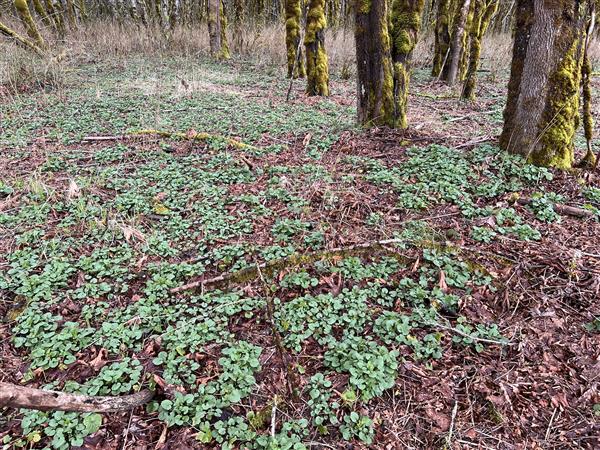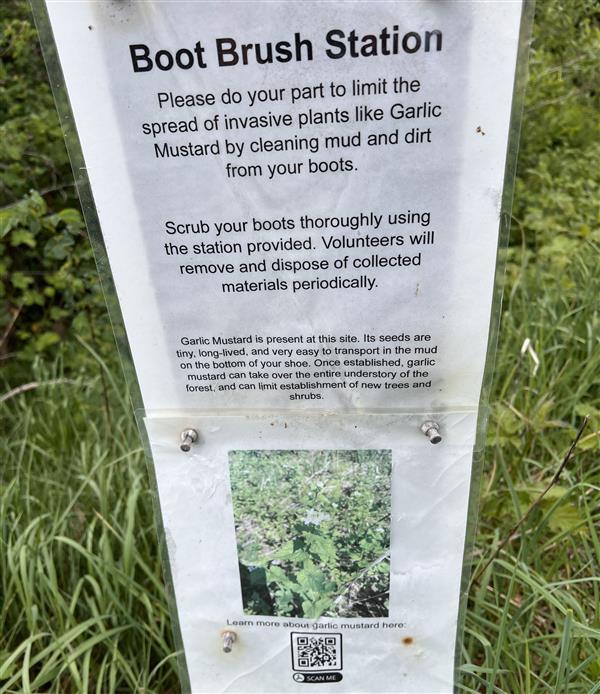A silent battle is underway in the forested understory of the Trust’s Pressentin Ranch Conservation Area, which lies along the Skagit River near Concrete. A fragrant invader, garlic mustard, threatens the balance of native ecosystems. Ongoing support and strategic effort from SLT’s Stewardship team are needed to keep this aggressive weed from gaining a foothold in our forests.

Garlic mustard, growing tall before being pulled by volunteers.
Garlic mustard first made its way to North America in the late 1800s, hitching a ride with settlers who brought it over from Europe and Asia as a culinary herb. While it may spice up a salad, it has become a formidable invasive species in some parts of the United States. If we don’t act quickly, this pungent pirate is likely to further invade and disturb Skagit ecosystems as well.
Skagit County’s Noxious Weed Control Board considers garlic mustard a Class-A Noxious Weed – a non-native, fast-spreading plant that has not yet become pervasive in our area (which means there’s still a chance to get rid of it). Unfortunately a mature garlic mustard plant can produce up to 8,000 seeds. It also releases chemicals into the soil that limit the growth of surrounding plants, is toxic to native butterfly larvae, and native wildlife don’t like to eat it.
.jpg&size=600)
In most situations, control of unwanted invasive species can be done using mechanical methods such as pulling, digging, cutting, and shading. With garlic mustard, early action is everything. Due to the large size of the infestation at Pressentin Ranch, contractors were hired in early spring to help combat garlic mustard during its hard-to-pull rosette stage (before it “bolts” or flowers).

Garlic mustard rosettes, which can be harder to pull than older plants.
Our Stewardship team returned later with volunteers to manually pull and pack out any remaining plants before they went to seed. We also carefully brushed our boots before leaving the site, and we will continue to monitor trails where seeds might have hitched a ride on boots or paws. Staff and volunteer fingers may reek of garlic for hours afterward, but it’s the smell of hard-earned progress!

The best way to prevent the spread of invasive species – whether in a Land Trust conservation area or in your backyard – is to plant native species. The second-best thing is to identify invasive plants and replace them with plants that spread less easily. However, sometimes the “seeds” have left the station, so here are a few tips on controlling invasive weeds on your property:
• Learn to identify local noxious weeds, especially Class-A and B species.
• Research the best times and methods for removing invasive species you find.
• Never put invasive weeds in your compost – dispose of them in the trash, or per county guidelines.
• Clean your boots and tools before leaving a site with known invasives.
• Attend and support the wonderful native plant sales that take place each spring and fall.
Removing invasive weeds requires patience and commitment. Thank you to our work party volunteers, land stewards, and landowners for pitching in and becoming part of the solution.
.jpg&size=600)
Volunteers pose proudly with the bags of garlic mustard they removed.